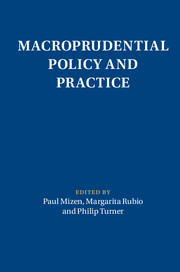Book contents
- Macroprudential Policy and Practice
- Macroeconomic Policy Making
- Macroprudential Policy and Practice
- Copyright page
- Contents
- Contributors
- Introduction
- 1 The Macroeconomics of Macroprudential Policies
- 2 A Liquidity-Based Approach to Macroprudential Policy*
- 3 Financial Intermediation and Monetary and Macroprudential Policies
- 4 The New Art of Central Banking
- 5 The Macroprudential Countercyclical Capital Buffer in Basel III
- 6 On the Use of Monetary and Macroprudential Policies for Small Open Economies
- 7 Capital Flows and Macroprudential Policy
- 8 Macroprudential Policy in a Globalised World
- 9 Systemic Risk of European Banks
- 10 Macroprudential Tools of Systemic Risk Analysis
- 11 When Is Macroprudential Policy Effective?
- 12 Macroprudential Policy
- Index
- References
11 - When Is Macroprudential Policy Effective?
Published online by Cambridge University Press: 09 August 2018
- Macroprudential Policy and Practice
- Macroeconomic Policy Making
- Macroprudential Policy and Practice
- Copyright page
- Contents
- Contributors
- Introduction
- 1 The Macroeconomics of Macroprudential Policies
- 2 A Liquidity-Based Approach to Macroprudential Policy*
- 3 Financial Intermediation and Monetary and Macroprudential Policies
- 4 The New Art of Central Banking
- 5 The Macroprudential Countercyclical Capital Buffer in Basel III
- 6 On the Use of Monetary and Macroprudential Policies for Small Open Economies
- 7 Capital Flows and Macroprudential Policy
- 8 Macroprudential Policy in a Globalised World
- 9 Systemic Risk of European Banks
- 10 Macroprudential Tools of Systemic Risk Analysis
- 11 When Is Macroprudential Policy Effective?
- 12 Macroprudential Policy
- Index
- References
Summary
Previous studies have shown that limits on loan-to-value (LTV) and debt-to-income (DTI) ratios can stabilize the housing market, and that tightening these limits tends to be more effective than loosening them. This paper examines whether the relative effectiveness of tightening versus loosening macroprudential measures depends on where in the housing cycle they are implemented. I find that tightening measures have greater effects when credit is expanding quickly and when house prices are high relative to income. Loosening measures seem to have smaller effects than tightening, but the difference is negligible in downturns. Loosening being found to have small effects is consistent with where it occurs in the cycle.
- Type
- Chapter
- Information
- Macroprudential Policy and Practice , pp. 248 - 274Publisher: Cambridge University PressPrint publication year: 2018
References
- 11
- Cited by



